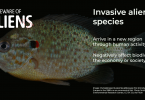With the pike and zander “season” well and truly under way now, many anglers will be considering using eel section as bait. We (the National Anguilla Club) ask pike and zander anglers to think again before the purchase a pack of eel sections or kill an eel to use as bait. Whilst “one or two” mature eels taken in this way will not affect stock levels, the quantity used by significant numbers of anglers will, and buying eel sections only feeds the market. If tackle dealers find that anglers do not buy them then they will not stock them. Your refusal to eels also sends a very clear message to other anglers and non anglers that we are serious about saving the species. The extract from a recent article shown below highlights the fact that there is no sustainable source for the eel:
The European Eel Anguilla anguilla is a complex and often misunderstood species. It starts life in the Sargasso Sea where it drifts on oceanic currents before reaching European shores up to 4 years later. From here, as Elvers, they migrate into our River systems where they spend up to 50 years, feeding and growing before returning back to the Sargasso to spawn.
This long lifecycle along with some natural and anthropogenic influence makes the species susceptible to possible extinction. It is already thought that the species has declined by approximately 99% since the 1980’s. This is alarming and has raised the question as to whether Eel stocks are sustainable.
The decline of the species has been reported since the 1940’s in Northern Europe and since the 1980’s in the rest of the continental range. Scientists from Indicang (pan European Eel research group) have demonstrated that Eel stocks are in decline and in some regions, mainly in the North of its distribution area, the situation is critical. Some restocking programmes (Northern Ireland, Baltic Sea and Italian lagoons) have succeeded in sustaining local fisheries but the decline continues where stocking has not been carried out. So what are the causes of this dramatic decline?
There are two major stages of the lifecycle which affect the decline in stocks
– Elver Recruitment
– Spawner escapement
Both are linked, it is thought that a reduction in spawning stock, caused by declining Eel stocks may be sufficient to cause a recruitment collapse as in 1980. There is evidence that the decline in recruitment was preceded by a decline in Eel landings approximately 2-3 decades earlier, as the time lag roughly corresponded to the generation period for faster growing stocks. Therefore, initial stock decline could not be caused by reduced recruitment but could be a potential cause of reduced recruitment.
Causes.
Recruitment Decline
– Over Exploitation
– Changes in oceanographical conditions, possibly linked to climate change
– Reduction in accessible freshwater habitat
– Pollution
– Parasitism
Stock Decline
– Over Exploitation
– Loss of good yellow Eel habitat, loss of wetlands, pollution, over abstraction.
– Barriers to migration, physical – weirs etc and water quality and quantity.
– Reduction in Elver stocking in waters beyond normal migration range.
Eels are not bred in captivity; aquaculture relies on the collection of seed Eels (Elvers) which are then grown on. This means that the species is unsustainable as ALL Eels sold in restaurants, shops and bait suppliers have been taken from the wild initially. The European Eel is currently deemed the most at risk vertebrate in the country and is currently on the IUCN Red list.
Help us save the eel – do not use them as bait!
THANK YOU
C.Daphne
Environment Officer
National Anguilla Club
The NAC are currently working alongside the Angling Trust and the Environment agency in order to save the species.








